Gothic Architecture: Tracing Its Origins, Features, and Evolution
VerifiedAdded on 2023/04/11
|10
|1274
|473
Essay
AI Summary
This essay provides an overview of Gothic architecture, tracing its origins from the Romanesque style in 12th-century France to its evolution across Western Europe. It highlights key characteristics such as pointed arches, ribbed vaults, and flying buttresses, which enabled the construction of taller, more light-filled structures like the abbey of Saint-Denis. The essay discusses the development of ornate stonework, tracery, and complex vaulting systems like lierne ribs and fan vaulting. It emphasizes the significance of light and airy interiors, decorative elements like gargoyles, and the overall aesthetic values that revolutionized building design. The essay also explores the impact of Gothic architecture on height and grace in buildings, facilitated by innovations like flying buttresses and vaulted ceilings, leading to grand and tall designs. Desklib provides access to similar essays and solved assignments for students.
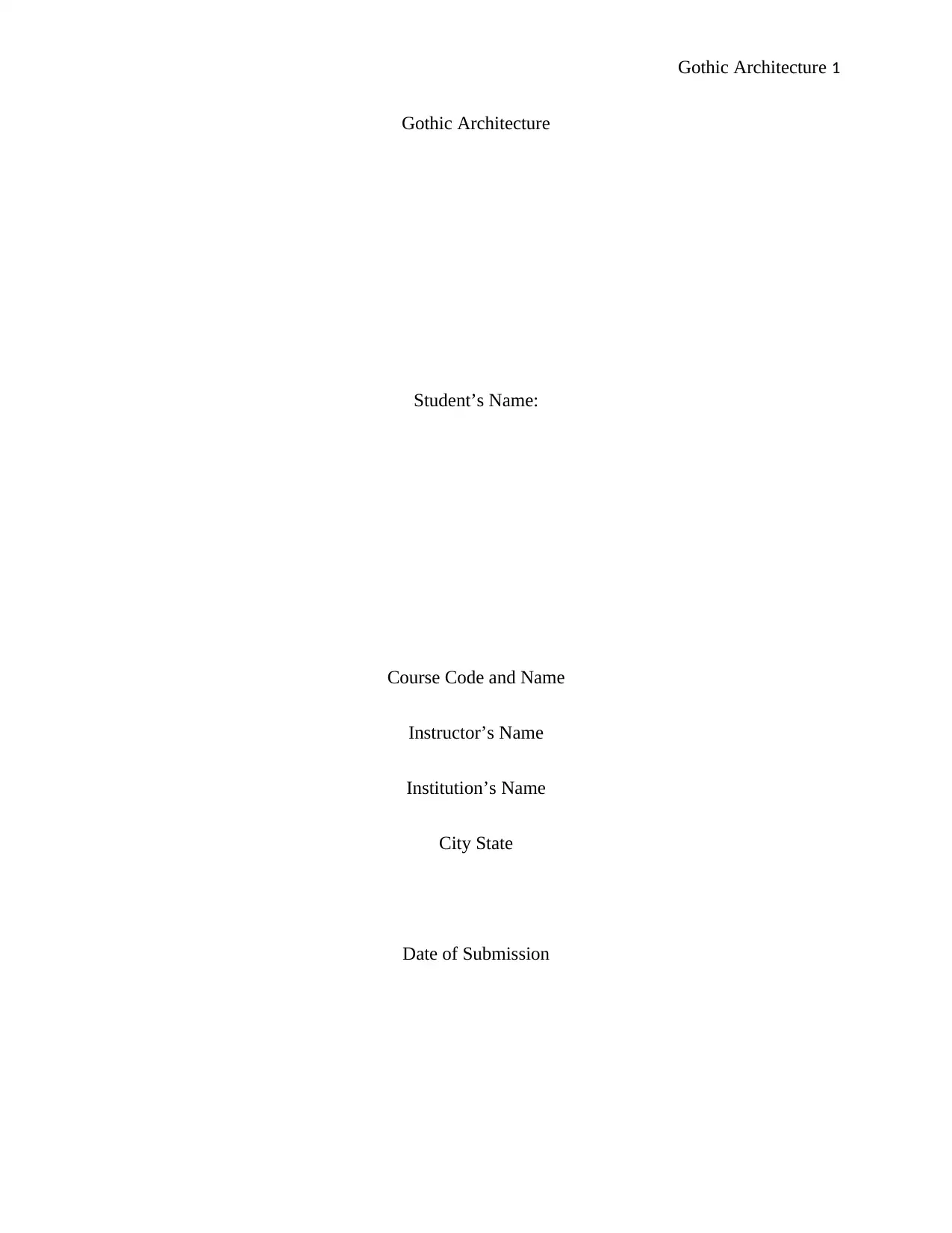
Gothic Architecture 1
Gothic Architecture
Student’s Name:
Course Code and Name
Instructor’s Name
Institution’s Name
City State
Date of Submission
Gothic Architecture
Student’s Name:
Course Code and Name
Instructor’s Name
Institution’s Name
City State
Date of Submission
Paraphrase This Document
Need a fresh take? Get an instant paraphrase of this document with our AI Paraphraser
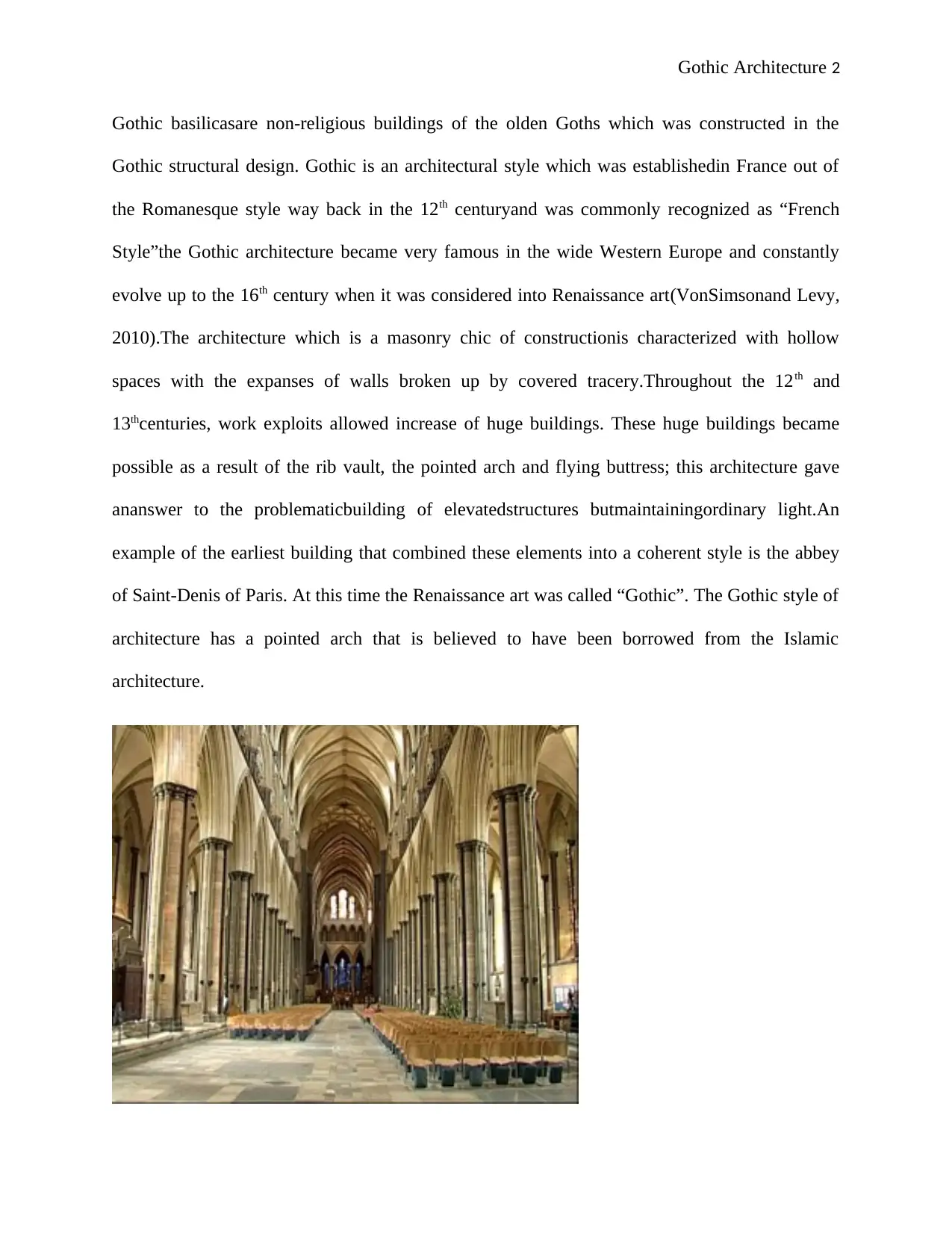
Gothic Architecture 2
Gothic basilicasare non-religious buildings of the olden Goths which was constructed in the
Gothic structural design. Gothic is an architectural style which was establishedin France out of
the Romanesque style way back in the 12th centuryand was commonly recognized as “French
Style”the Gothic architecture became very famous in the wide Western Europe and constantly
evolve up to the 16th century when it was considered into Renaissance art(VonSimsonand Levy,
2010).The architecture which is a masonry chic of constructionis characterized with hollow
spaces with the expanses of walls broken up by covered tracery.Throughout the 12th and
13thcenturies, work exploits allowed increase of huge buildings. These huge buildings became
possible as a result of the rib vault, the pointed arch and flying buttress; this architecture gave
ananswer to the problematicbuilding of elevatedstructures butmaintainingordinary light.An
example of the earliest building that combined these elements into a coherent style is the abbey
of Saint-Denis of Paris. At this time the Renaissance art was called “Gothic”. The Gothic style of
architecture has a pointed arch that is believed to have been borrowed from the Islamic
architecture.
Gothic basilicasare non-religious buildings of the olden Goths which was constructed in the
Gothic structural design. Gothic is an architectural style which was establishedin France out of
the Romanesque style way back in the 12th centuryand was commonly recognized as “French
Style”the Gothic architecture became very famous in the wide Western Europe and constantly
evolve up to the 16th century when it was considered into Renaissance art(VonSimsonand Levy,
2010).The architecture which is a masonry chic of constructionis characterized with hollow
spaces with the expanses of walls broken up by covered tracery.Throughout the 12th and
13thcenturies, work exploits allowed increase of huge buildings. These huge buildings became
possible as a result of the rib vault, the pointed arch and flying buttress; this architecture gave
ananswer to the problematicbuilding of elevatedstructures butmaintainingordinary light.An
example of the earliest building that combined these elements into a coherent style is the abbey
of Saint-Denis of Paris. At this time the Renaissance art was called “Gothic”. The Gothic style of
architecture has a pointed arch that is believed to have been borrowed from the Islamic
architecture.
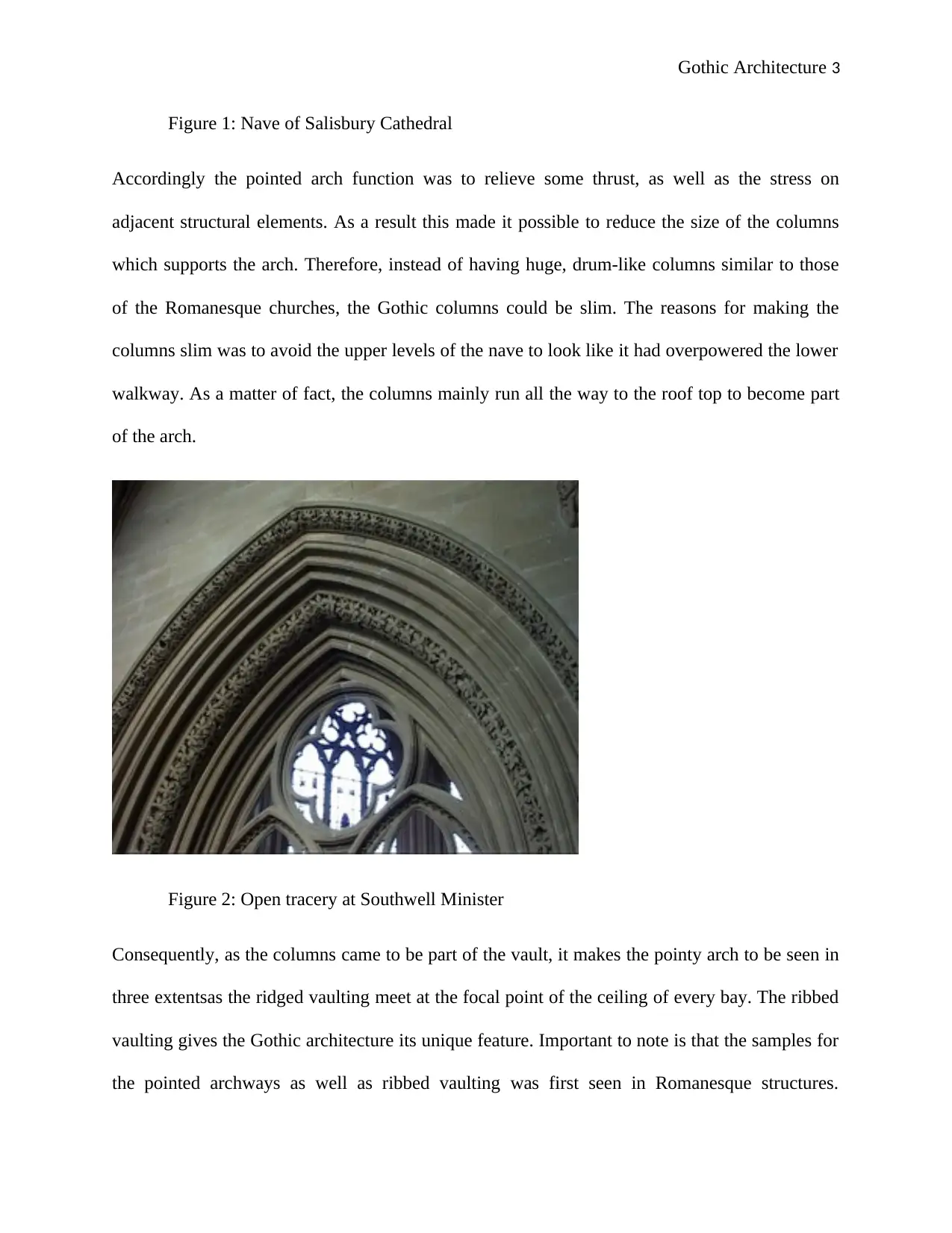
Gothic Architecture 3
Figure 1: Nave of Salisbury Cathedral
Accordingly the pointed arch function was to relieve some thrust, as well as the stress on
adjacent structural elements. As a result this made it possible to reduce the size of the columns
which supports the arch. Therefore, instead of having huge, drum-like columns similar to those
of the Romanesque churches, the Gothic columns could be slim. The reasons for making the
columns slim was to avoid the upper levels of the nave to look like it had overpowered the lower
walkway. As a matter of fact, the columns mainly run all the way to the roof top to become part
of the arch.
Figure 2: Open tracery at Southwell Minister
Consequently, as the columns came to be part of the vault, it makes the pointy arch to be seen in
three extentsas the ridged vaulting meet at the focal point of the ceiling of every bay. The ribbed
vaulting gives the Gothic architecture its unique feature. Important to note is that the samples for
the pointed archways as well as ribbed vaulting was first seen in Romanesque structures.
Figure 1: Nave of Salisbury Cathedral
Accordingly the pointed arch function was to relieve some thrust, as well as the stress on
adjacent structural elements. As a result this made it possible to reduce the size of the columns
which supports the arch. Therefore, instead of having huge, drum-like columns similar to those
of the Romanesque churches, the Gothic columns could be slim. The reasons for making the
columns slim was to avoid the upper levels of the nave to look like it had overpowered the lower
walkway. As a matter of fact, the columns mainly run all the way to the roof top to become part
of the arch.
Figure 2: Open tracery at Southwell Minister
Consequently, as the columns came to be part of the vault, it makes the pointy arch to be seen in
three extentsas the ridged vaulting meet at the focal point of the ceiling of every bay. The ribbed
vaulting gives the Gothic architecture its unique feature. Important to note is that the samples for
the pointed archways as well as ribbed vaulting was first seen in Romanesque structures.
⊘ This is a preview!⊘
Do you want full access?
Subscribe today to unlock all pages.

Trusted by 1+ million students worldwide
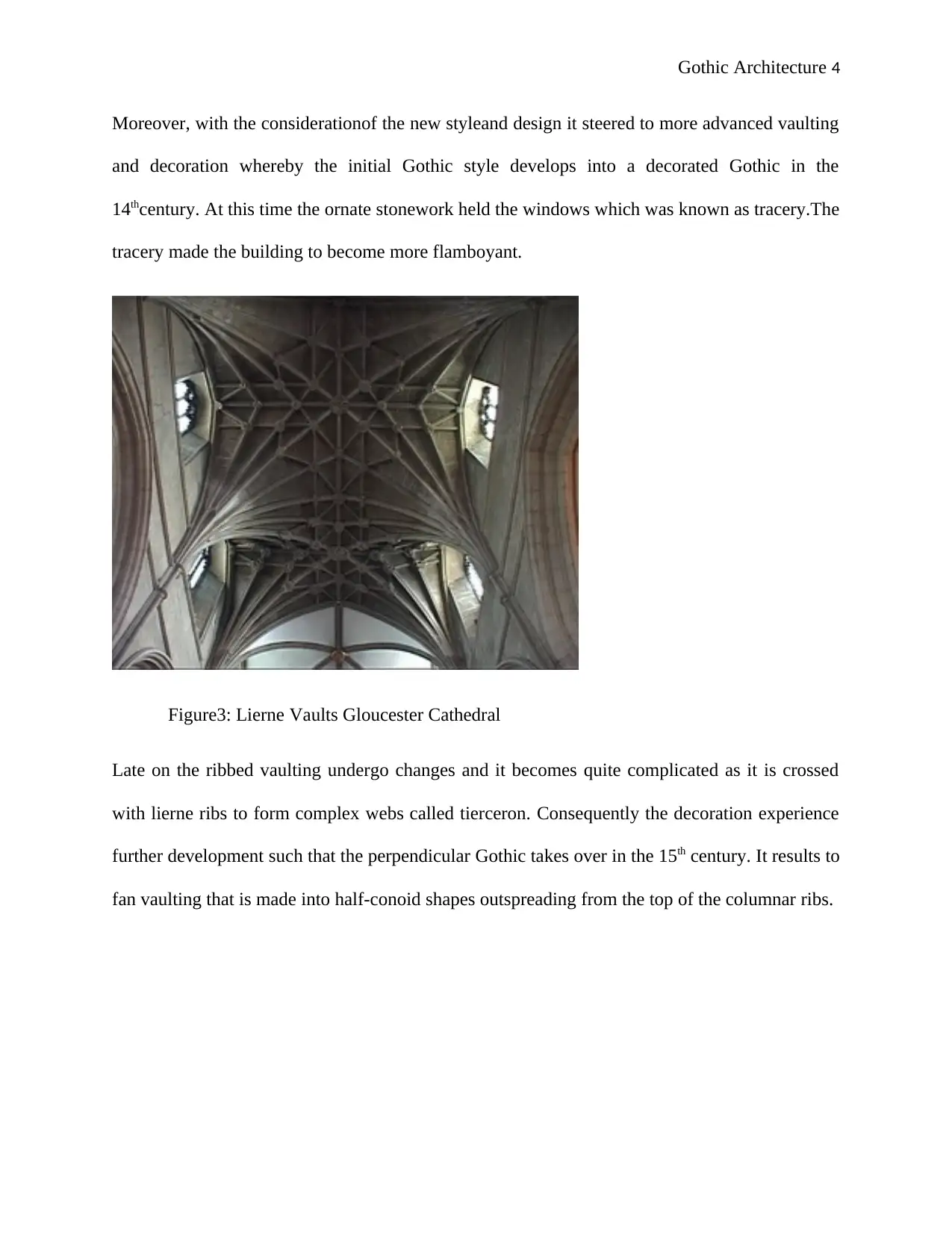
Gothic Architecture 4
Moreover, with the considerationof the new styleand design it steered to more advanced vaulting
and decoration whereby the initial Gothic style develops into a decorated Gothic in the
14thcentury. At this time the ornate stonework held the windows which was known as tracery.The
tracery made the building to become more flamboyant.
Figure3: Lierne Vaults Gloucester Cathedral
Late on the ribbed vaulting undergo changes and it becomes quite complicated as it is crossed
with lierne ribs to form complex webs called tierceron. Consequently the decoration experience
further development such that the perpendicular Gothic takes over in the 15th century. It results to
fan vaulting that is made into half-conoid shapes outspreading from the top of the columnar ribs.
Moreover, with the considerationof the new styleand design it steered to more advanced vaulting
and decoration whereby the initial Gothic style develops into a decorated Gothic in the
14thcentury. At this time the ornate stonework held the windows which was known as tracery.The
tracery made the building to become more flamboyant.
Figure3: Lierne Vaults Gloucester Cathedral
Late on the ribbed vaulting undergo changes and it becomes quite complicated as it is crossed
with lierne ribs to form complex webs called tierceron. Consequently the decoration experience
further development such that the perpendicular Gothic takes over in the 15th century. It results to
fan vaulting that is made into half-conoid shapes outspreading from the top of the columnar ribs.
Paraphrase This Document
Need a fresh take? Get an instant paraphrase of this document with our AI Paraphraser
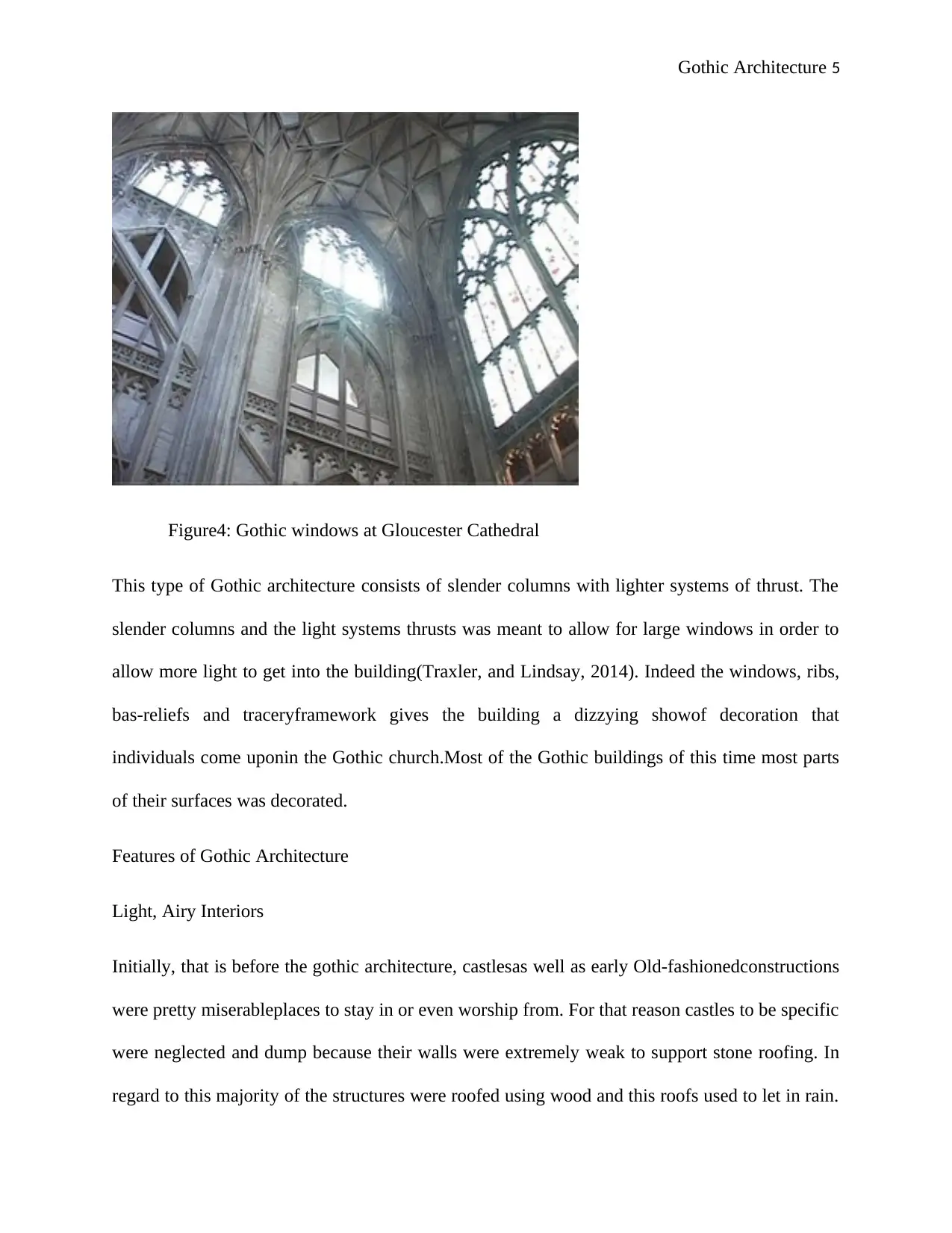
Gothic Architecture 5
Figure4: Gothic windows at Gloucester Cathedral
This type of Gothic architecture consists of slender columns with lighter systems of thrust. The
slender columns and the light systems thrusts was meant to allow for large windows in order to
allow more light to get into the building(Traxler, and Lindsay, 2014). Indeed the windows, ribs,
bas-reliefs and traceryframework gives the building a dizzying showof decoration that
individuals come uponin the Gothic church.Most of the Gothic buildings of this time most parts
of their surfaces was decorated.
Features of Gothic Architecture
Light, Airy Interiors
Initially, that is before the gothic architecture, castlesas well as early Old-fashionedconstructions
were pretty miserableplaces to stay in or even worship from. For that reason castles to be specific
were neglected and dump because their walls were extremely weak to support stone roofing. In
regard to this majority of the structures were roofed using wood and this roofs used to let in rain.
Figure4: Gothic windows at Gloucester Cathedral
This type of Gothic architecture consists of slender columns with lighter systems of thrust. The
slender columns and the light systems thrusts was meant to allow for large windows in order to
allow more light to get into the building(Traxler, and Lindsay, 2014). Indeed the windows, ribs,
bas-reliefs and traceryframework gives the building a dizzying showof decoration that
individuals come uponin the Gothic church.Most of the Gothic buildings of this time most parts
of their surfaces was decorated.
Features of Gothic Architecture
Light, Airy Interiors
Initially, that is before the gothic architecture, castlesas well as early Old-fashionedconstructions
were pretty miserableplaces to stay in or even worship from. For that reason castles to be specific
were neglected and dump because their walls were extremely weak to support stone roofing. In
regard to this majority of the structures were roofed using wood and this roofs used to let in rain.
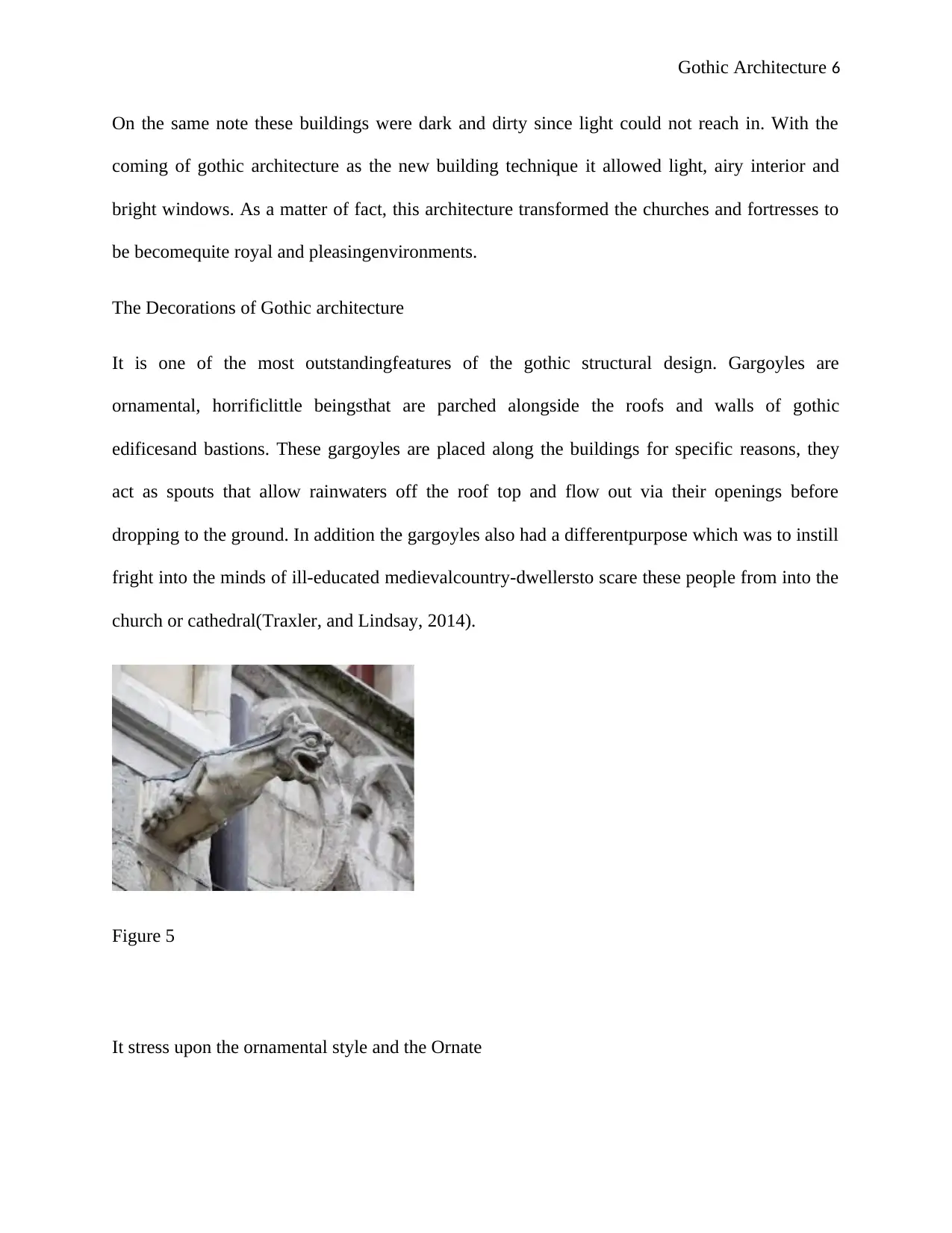
Gothic Architecture 6
On the same note these buildings were dark and dirty since light could not reach in. With the
coming of gothic architecture as the new building technique it allowed light, airy interior and
bright windows. As a matter of fact, this architecture transformed the churches and fortresses to
be becomequite royal and pleasingenvironments.
The Decorations of Gothic architecture
It is one of the most outstandingfeatures of the gothic structural design. Gargoyles are
ornamental, horrificlittle beingsthat are parched alongside the roofs and walls of gothic
edificesand bastions. These gargoyles are placed along the buildings for specific reasons, they
act as spouts that allow rainwaters off the roof top and flow out via their openings before
dropping to the ground. In addition the gargoyles also had a differentpurpose which was to instill
fright into the minds of ill-educated medievalcountry-dwellersto scare these people from into the
church or cathedral(Traxler, and Lindsay, 2014).
Figure 5
It stress upon the ornamental style and the Ornate
On the same note these buildings were dark and dirty since light could not reach in. With the
coming of gothic architecture as the new building technique it allowed light, airy interior and
bright windows. As a matter of fact, this architecture transformed the churches and fortresses to
be becomequite royal and pleasingenvironments.
The Decorations of Gothic architecture
It is one of the most outstandingfeatures of the gothic structural design. Gargoyles are
ornamental, horrificlittle beingsthat are parched alongside the roofs and walls of gothic
edificesand bastions. These gargoyles are placed along the buildings for specific reasons, they
act as spouts that allow rainwaters off the roof top and flow out via their openings before
dropping to the ground. In addition the gargoyles also had a differentpurpose which was to instill
fright into the minds of ill-educated medievalcountry-dwellersto scare these people from into the
church or cathedral(Traxler, and Lindsay, 2014).
Figure 5
It stress upon the ornamental style and the Ornate
⊘ This is a preview!⊘
Do you want full access?
Subscribe today to unlock all pages.

Trusted by 1+ million students worldwide
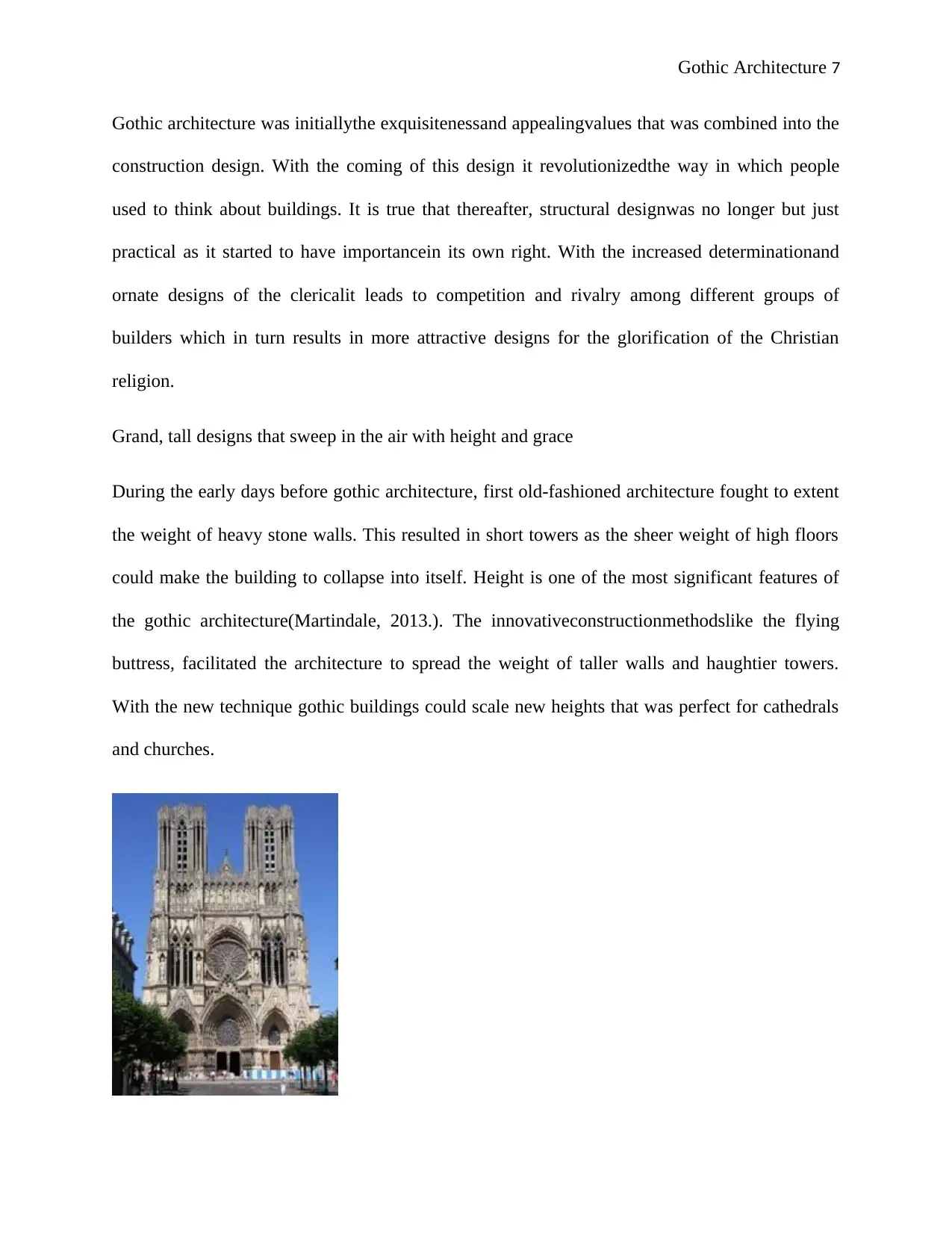
Gothic Architecture 7
Gothic architecture was initiallythe exquisitenessand appealingvalues that was combined into the
construction design. With the coming of this design it revolutionizedthe way in which people
used to think about buildings. It is true that thereafter, structural designwas no longer but just
practical as it started to have importancein its own right. With the increased determinationand
ornate designs of the clericalit leads to competition and rivalry among different groups of
builders which in turn results in more attractive designs for the glorification of the Christian
religion.
Grand, tall designs that sweep in the air with height and grace
During the early days before gothic architecture, first old-fashioned architecture fought to extent
the weight of heavy stone walls. This resulted in short towers as the sheer weight of high floors
could make the building to collapse into itself. Height is one of the most significant features of
the gothic architecture(Martindale, 2013.). The innovativeconstructionmethodslike the flying
buttress, facilitated the architecture to spread the weight of taller walls and haughtier towers.
With the new technique gothic buildings could scale new heights that was perfect for cathedrals
and churches.
Gothic architecture was initiallythe exquisitenessand appealingvalues that was combined into the
construction design. With the coming of this design it revolutionizedthe way in which people
used to think about buildings. It is true that thereafter, structural designwas no longer but just
practical as it started to have importancein its own right. With the increased determinationand
ornate designs of the clericalit leads to competition and rivalry among different groups of
builders which in turn results in more attractive designs for the glorification of the Christian
religion.
Grand, tall designs that sweep in the air with height and grace
During the early days before gothic architecture, first old-fashioned architecture fought to extent
the weight of heavy stone walls. This resulted in short towers as the sheer weight of high floors
could make the building to collapse into itself. Height is one of the most significant features of
the gothic architecture(Martindale, 2013.). The innovativeconstructionmethodslike the flying
buttress, facilitated the architecture to spread the weight of taller walls and haughtier towers.
With the new technique gothic buildings could scale new heights that was perfect for cathedrals
and churches.
Paraphrase This Document
Need a fresh take? Get an instant paraphrase of this document with our AI Paraphraser
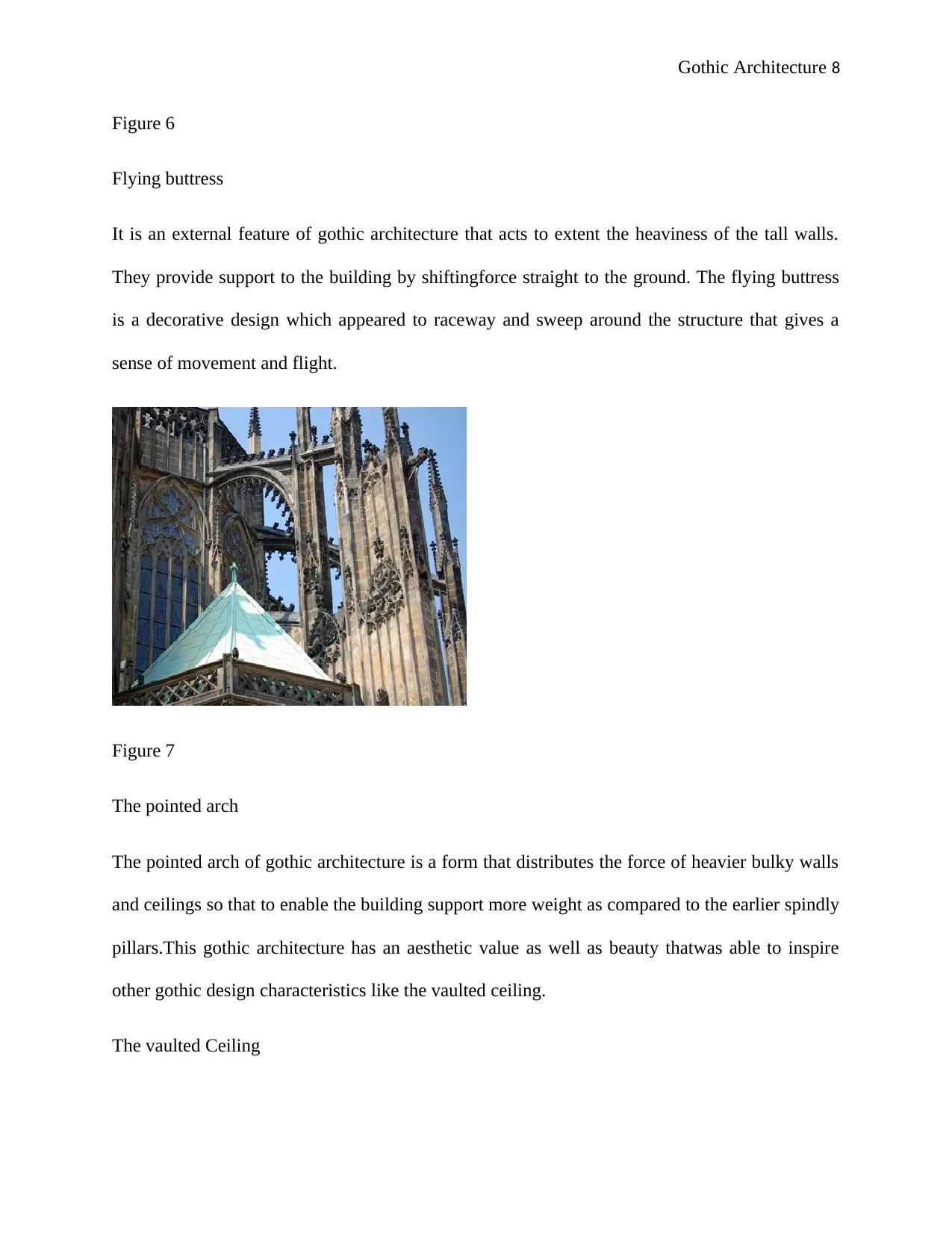
Gothic Architecture 8
Figure 6
Flying buttress
It is an external feature of gothic architecture that acts to extent the heaviness of the tall walls.
They provide support to the building by shiftingforce straight to the ground. The flying buttress
is a decorative design which appeared to raceway and sweep around the structure that gives a
sense of movement and flight.
Figure 7
The pointed arch
The pointed arch of gothic architecture is a form that distributes the force of heavier bulky walls
and ceilings so that to enable the building support more weight as compared to the earlier spindly
pillars.This gothic architecture has an aesthetic value as well as beauty thatwas able to inspire
other gothic design characteristics like the vaulted ceiling.
The vaulted Ceiling
Figure 6
Flying buttress
It is an external feature of gothic architecture that acts to extent the heaviness of the tall walls.
They provide support to the building by shiftingforce straight to the ground. The flying buttress
is a decorative design which appeared to raceway and sweep around the structure that gives a
sense of movement and flight.
Figure 7
The pointed arch
The pointed arch of gothic architecture is a form that distributes the force of heavier bulky walls
and ceilings so that to enable the building support more weight as compared to the earlier spindly
pillars.This gothic architecture has an aesthetic value as well as beauty thatwas able to inspire
other gothic design characteristics like the vaulted ceiling.
The vaulted Ceiling
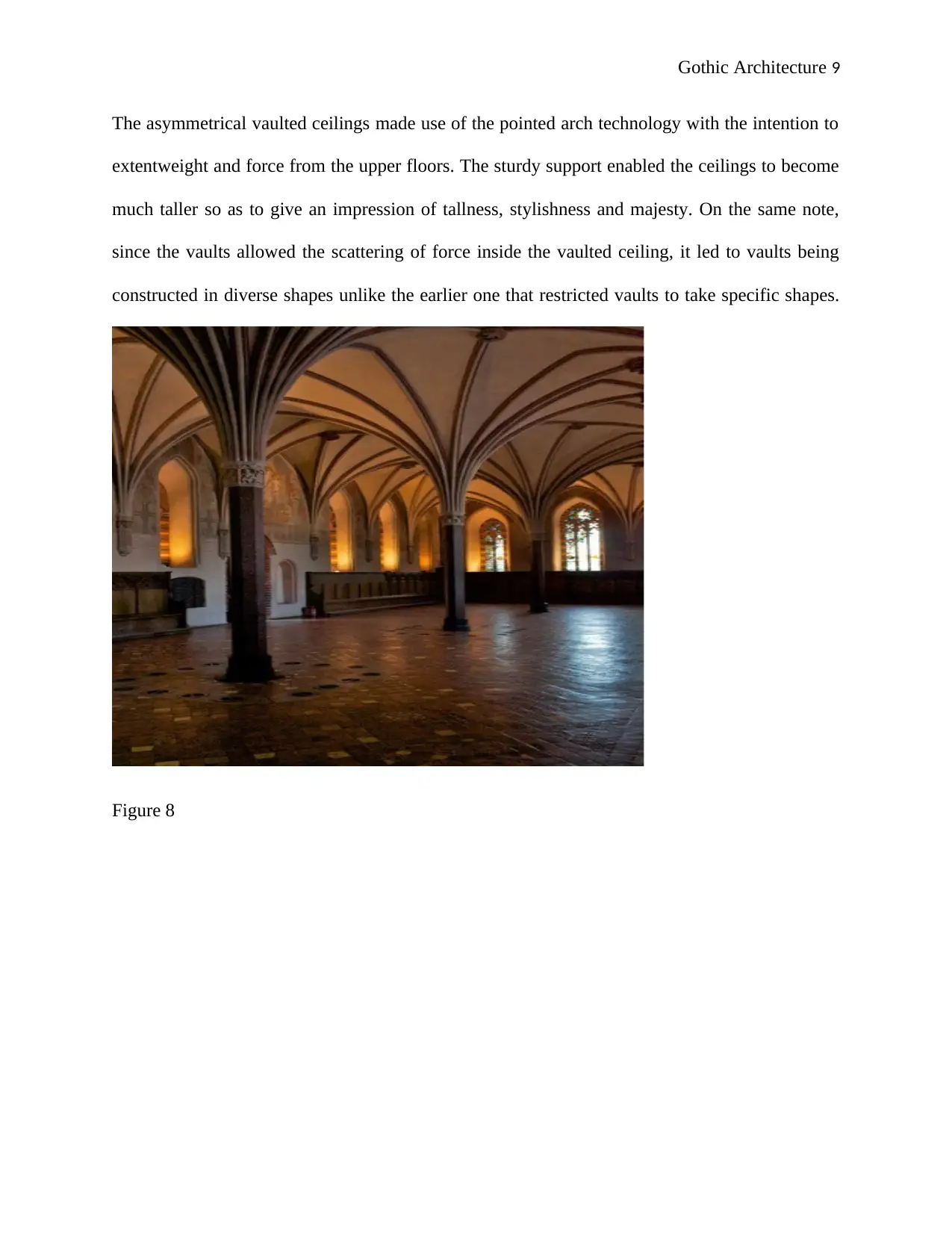
Gothic Architecture 9
The asymmetrical vaulted ceilings made use of the pointed arch technology with the intention to
extentweight and force from the upper floors. The sturdy support enabled the ceilings to become
much taller so as to give an impression of tallness, stylishness and majesty. On the same note,
since the vaults allowed the scattering of force inside the vaulted ceiling, it led to vaults being
constructed in diverse shapes unlike the earlier one that restricted vaults to take specific shapes.
Figure 8
The asymmetrical vaulted ceilings made use of the pointed arch technology with the intention to
extentweight and force from the upper floors. The sturdy support enabled the ceilings to become
much taller so as to give an impression of tallness, stylishness and majesty. On the same note,
since the vaults allowed the scattering of force inside the vaulted ceiling, it led to vaults being
constructed in diverse shapes unlike the earlier one that restricted vaults to take specific shapes.
Figure 8
⊘ This is a preview!⊘
Do you want full access?
Subscribe today to unlock all pages.

Trusted by 1+ million students worldwide
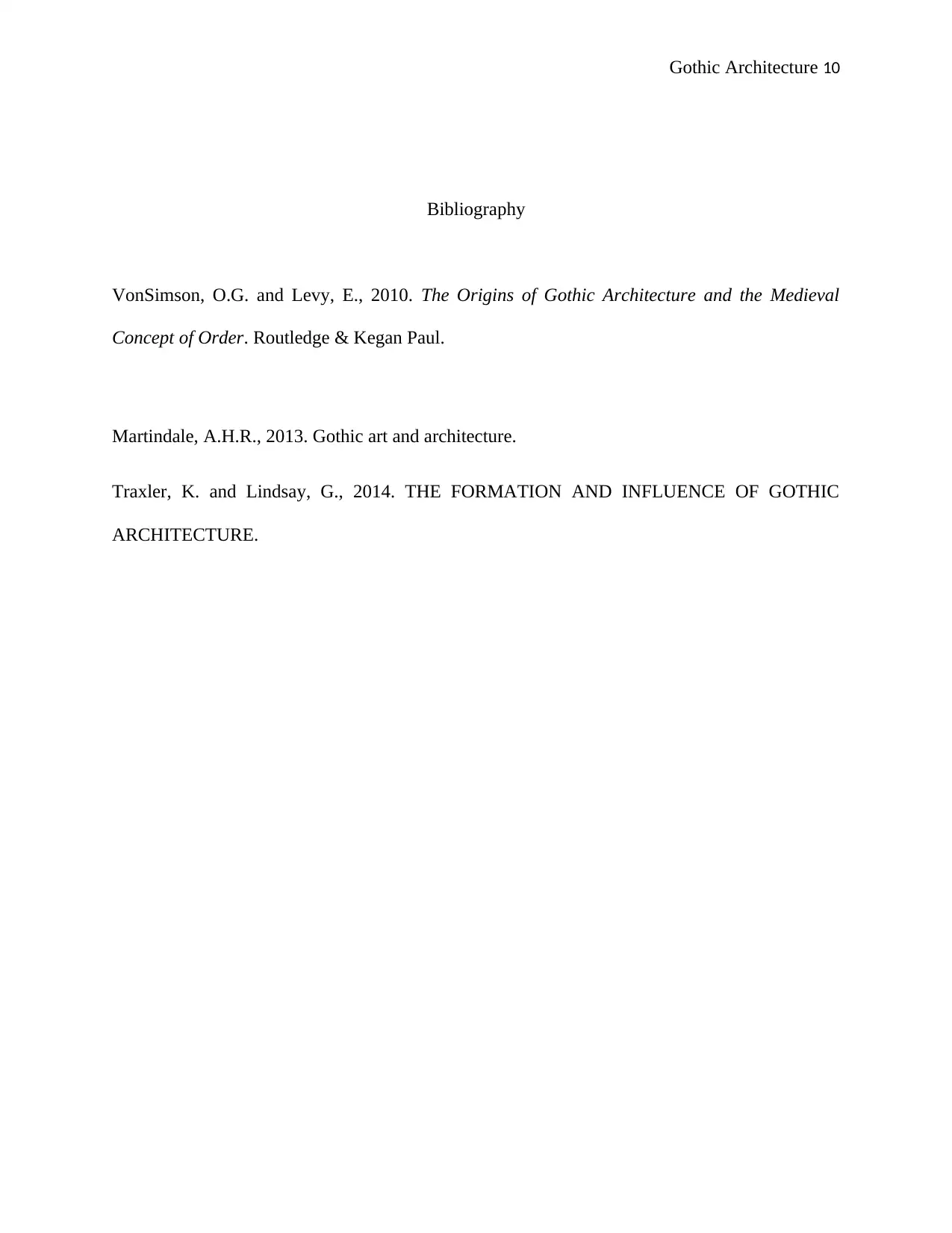
Gothic Architecture 10
Bibliography
VonSimson, O.G. and Levy, E., 2010. The Origins of Gothic Architecture and the Medieval
Concept of Order. Routledge & Kegan Paul.
Martindale, A.H.R., 2013. Gothic art and architecture.
Traxler, K. and Lindsay, G., 2014. THE FORMATION AND INFLUENCE OF GOTHIC
ARCHITECTURE.
Bibliography
VonSimson, O.G. and Levy, E., 2010. The Origins of Gothic Architecture and the Medieval
Concept of Order. Routledge & Kegan Paul.
Martindale, A.H.R., 2013. Gothic art and architecture.
Traxler, K. and Lindsay, G., 2014. THE FORMATION AND INFLUENCE OF GOTHIC
ARCHITECTURE.
1 out of 10
Related Documents
Your All-in-One AI-Powered Toolkit for Academic Success.
+13062052269
info@desklib.com
Available 24*7 on WhatsApp / Email
![[object Object]](/_next/static/media/star-bottom.7253800d.svg)
Unlock your academic potential
Copyright © 2020–2025 A2Z Services. All Rights Reserved. Developed and managed by ZUCOL.




